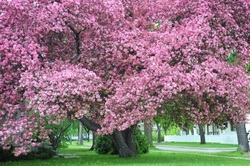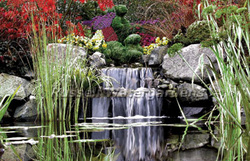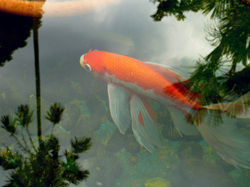By Clifford Woods Which Trees Can I Plant Near My Fish Pond?  For pond keepers, it is essential to make sure that particular types of tree which are toxic are placed far from your fish pond. Most tree varieties lose their leaves, especially throughout the autumn season. You definitely do not want your pond fish to consume any of the toxic leaves that may fall into your pond; it could ruin their eating habits. On top of that, leaves are not nutritious for any fish.
Regardless of whether the leaves are dangerous or not, the elevated amounts of organic matter dropping into the fish pond is harmful as the leaves will at some point rot and sink to the bottom of the pond. Rotting plant life raises the amounts of carbon dioxide and ammonia in the water, which is extremely bad for the well-being of your fish.
A net spread over the pond is a practical option, yet it does take away from the overall physical appeal and experience of the fish pond. Nets may be necessary, or you could simply select tree species that do not shed a significant number of leaves.
There are some tree varieties that will surely supply a pleasant experience and shade for your goldfish, Koi and other aquatic life in your pond from a scorching summer day. The shade from the trees you choose will help to filter out ultraviolet rays, which subsequently assists in the management of algae. The cooler water allows oxygen to break down from the environment into the water considerably more effortlessly.When deciding upon trees to position around a fish pond, steer clear of the following: Additional types, while not particularly toxic, do possess huge root systems which will at some point hinder your pond liners are Sycamores and Willows. These are just two primarily examples of trees with large root systems that you should keep away from. Here also is a lists of a few trees appropriate for growing in gardens with fish ponds:
- Crab Apples are relatively tiny trees types which are a fantastic choice for gardening around a fish pond. The Japanese Crab Apple, as well as the fragrant Malus Pink Perfection are both excellent possibilities.
- The Swedish Silver Birch is fantastic if you are searching for mild foliage and a bark that progressively becomes white in color as time passes. For those who have an outside Pergola, positioned close to your fish pond and are seeking to add a few evergreen climbing plants next to it ensure that you stay away from deciduous plants like ivy. This particular plant type is among the most toxic of all climbers.
- A number of the ash tree types make the perfect option, since their root system is fairly compact and they tend not to cast an excessive amount of shade. The Mountain Ash tree has umbel-type blossoms in spring, accompanied by vibrant reddish berries in the autumn which are practically eclipsed by the spectacular red vegetation. The Japanese Mountain Ash yields sizeable orange berries.
Additional options are Mays or Hawthorns, especially if you require a tough and hardy plant. For those who desire an autumn look, a Crataegus prunifolia may be a good choice for you.
If you really have a desire for an evergreen deciduous climbing plant, then a Silver Queen is an excellent choice since it grows quickly and scarcely flowers; from time to time it does develop blossoms, however it is simple to prune them.
In case you already have an accumulation of decayed leaves in your pond, it is likely that algae are beginning to form if it hasn't already spread. An algaecide containing beneficial microorganisms is exactly what you need in order to obtain a thriving pond free of all bad bacteria.
 Author: Clifford Woods is the CEO of Effective Environmental Services and Organic Environmental Technology.
We brew Beneficial Microorganisms that eat toxins in the environment and offer Naturally Organic Solutions.
The Basics of Pond Care by Clifford Woods  Proper pond care is comparatively straightforward on the condition that the pond is well-made in advance of putting fish into it as well as being properly maintained when in operation.
With both ponds and pools, you need to make sure that the proper water levels are taken care of, either by filling it in excess for the duration of hot weather seasons or depleting it in the course of rainier periods. This will prevent undue weathering of exposed areas of pond liner or erosion of banks if flooding occurs.
Splits in cement or holes in liners can often be fixed, however it is quite time intensive and certainly an issue worthy of avoidance. Appropriately blended cement should never fracture even during extreme climate changes. Most shredding in liners is a result of inappropriate selection of the proper fish pond liner in advance of installation, additional reasons are the feared visits from the otter, heron, raccoon, and other similar animals whose razor-sharp claws can effortlessly pierce weaker pond liners.
Fish Care
Assuming that your pond water is properly oxygenated and fish aren't over-fed, the fish should continue to be healthy. However, if you do observe fish behaving out of character or floating around too lethargically then in that case it is advisable to contact your local pond fish authorities. Protrusions or skin lesions are evident indications of stressed fish and really should be dealt with the instant it is observed.
Once again, a quick call to your own personal local fish pond treatment company to ask for a precise analysis and what therapy should be done is usually adequate to save your pond fish.
Seasonal Care
The later part of the fall and winter are generally not the ideal times of year to thoroughly clean your pond, as you will most likely disrupt all of the vegetation and fish attempting to adapt to the winter season. A few plants send down sprouts to the bottom level of the pond exactly where they sit until the weather conditions become a bit warmer.
The perfect time for an effective clean up is in early spring, following the last frosts, whenever pond life is back to being lively and the fish start to eat actively. Normally it is not recommended to completely drain and clean out ponds as this tends to get rid of the friendly microorganisms as well.
Improve Appearance and Protect Your Pond
To enhance the visual appeal of the pond as well as to protect against disease, get rid of any decaying plant life from the water and small vegetation following the initial couple of frosts at the beginning of fall, excessive floating vegetation that appears lifeless also needs to be taken out with a net or rake.
Fish during this period aren't going to be feeding and will essentially survive on their very own body fats for the rest of the winter season. Be sure you provide them with sufficient protection by means of ledges, rocks, or extremely deep water where they are able to hide securely.
Algae
Green unclean water is a frequent issue with more compact ponds. A small amount of algae exists in all water; having said that, in lengthier intervals of sunlight even an ideal equilibrium of fish and plants is just not sufficient for complete avoidance and the water can becomes a livid green color. In tiny still-water garden ponds this can be prevented with the setup of a purification unit such as UV sterilizers.
The UV light can eliminates algae cells, while the filtration system gets rid of its inactive organic matter well before it can lead to more complications. One particular method for eliminating algae would be to use an algaecide abundant with beneficial microorganisms.
A probiotics solution may be helpful in getting rid of algae completely as well as boost the overall health of the pond environment.

 It is a known fact that clean water is essential to all living things to be able to survive. With the environmental changes occurring at present, however, the environment is at risk of losing clean water with all the uncontrolled pollutants that are incorporated in the water system. There might be a time when clean water scarcity will be experienced all around the world.
One solution in addressing the problem of contaminated water is the use of beneficial microorganisms.
Beneficial microorganisms, either in the form of bacteria or fungi, have the ability to breakdown almost anything to use them for food as a source of energy. They are the reason for the decay of organic materials in the environment. Beneficial microorganisms, which we commonly term as good bacteria, are very helpful to the body since they fight harmful microorganisms or bad bacteria. Aside from their benefits in the body, they also have some benefits in our environment, such as helping in production of clean water.
These beneficial microorganisms are versatile; they can adapt to any type of environment they are in. These have the ability to clean water and thus, they are incorporated to dirty ponds and lakes that need to be cleaned up. Although there are natural floras already present in the local environment, they have already been depleted by pollution and thus, the need to incorporate cultured microorganisms into them is imminent.
Beneficial microorganisms may be incorporated in ponds to produce clean water. Some types of beneficial microorganisms break down toxic ammonia present in ponds. They break them down into nitrites, which are converted into a useful form. An increase of nutrients present in the pond environment can also become harmful, beneficial microorganisms also feed on these excess nutrients.
A pond that is full of algae and dead plants has its oxygen content of the water depleted. The introduction of beneficial microorganisms can help clean water by feeding on these dead plants and algae and emitting oxygen back into the water. The pungent odors due to increase in algae and dead plants are also reduced. In this way, other living things present in ponds and lakes, such as fish are able to thrive in the environment. And people enjoy the clean water caused by beneficial microorganisms too.
Bad bacteria present in a pond environment can cause illness to humans resulting in ulcers, septicemia, and gastroenteritis. These harmful microorganisms are incorporated into water systems that mix with water sources and then come out in tap water, which all the while is thought as clean water. Beneficial microorganisms can eliminate stomach illnesses by releasing antibacterial properties.
Beneficial microorganisms are able to balance the ecosystem to help other living things to thrive, such as in the case of ponds and lakes to keep clean water flowing.
However, if the beneficial microorganism is out-numbered by harmful microorganisms and substances, the rate of pollution is faster than the breakdown from the beneficial microorganisms. They cannot do the entire job alone and so there is a need for humans to maintain cleanliness in the environment and to reduce pollution as much as possible to have unending supply of clean water.
It is important to implement methods that will keep the correct balance of both algae and bacteria so that a healthy ecosystem is maintained. Where matter and waste are allowed to collect in the bottom of the pond, the oxygen content eventually decreases, which means that beneficial bacteria or microorganisms are unable to control for high levels of ammonia and nitrites. Even the application of a pump or filter to aerate the water will prove ineffective.
Author: Clifford Woods is the CEO of Effective Environmental Services and Organic Environmental Technology
 The Value of Clean Ponds to the Environment
By Clifford Woods
Environment has remained the most neglected entity in the world throughout history with industrialists and businessmen totally forgetting that they live in a world, which they share with other creatures. This neglect of the surroundings we live in has resulted in severe consequences for us humans in the present day and age, which are going to affect our future generations as well.
It is for this reason that people nowadays have started putting the environment above everything else. Business corporations and industries have started paying attention to the ecological system and are trying to find out ways to limit the pollution and to preserve our natural resources.
Why Is Cleaning a Pond so Necessary? Ponds are among the environments most polluted components. This is why finding a clean pond has become a rarity nowadays. All the polluted water from the factories and industries is dumped in these lakes, which has caused these freshwater havens for many creatures to become unclean and the breeding ground for mosquitoes and other insects. Thus, cleaning a pond is not only necessary for providing a healthy environment for useful garden animals like frogs and toads but also for keeping the population of mosquitoes under control.
How to Clean a Pond: For cleaning a pond, the use of an organic cleaner has proven to be vital for the safety of the other animals living in the pond. An inorganic chemical used as a cleaner can prove to be harmful for the aquatic life that lives there and can severely damage their population. Moreover, the use of chemicals also lowers the quality of the water and makes it unsafe for humans as well. Therefore, in order to clean a pond, it is vital that only the use an organic cleaner should be attempted, as it would keep the pond clean without posing any threat to the aquatic life that lives there.
Environmental Benefits of Clean Ponds: A clean pond can be of great value to the environment. Not only does a pond make the atmosphere cleaner and provide water and a breeding place for many animals, it also provides people a chance to enjoy nature in its purest form.
In addition to this, clean ponds are great substitutes for gardens and since they have no grass they do not need to be mowed every few days, thus they save a lot of electricity that would have been used in mowing the lawns.
Another great environmental benefit of a clear pond is that its underwater soil is nutrient rich and can be used as natural fertilizer for in-door plants, thus saving a person the need to use chemical fertilizer for nourishing his plants. As the ponds do not require as much water because of their ability to store water from rainfall, they keep the water consumption down and help in saving water as well.
It is because of these amazing environmental benefits that ponds are considered an important constituent of our ecological system and are of great value to us. Having a clean clear pond is a blessing for a community or a household as it keeps the natural balance and provides a soulful place for the people to relax and enjoy the beauty of nature.
Therefore, if you want to enjoy the ecological benefits that a clean pond can provide then always remember to use organic pond cleaners in your pond.
|







 RSS Feed
RSS Feed